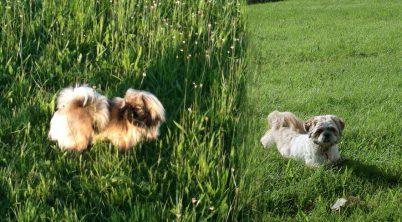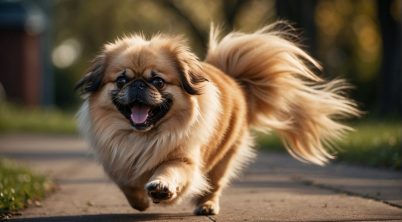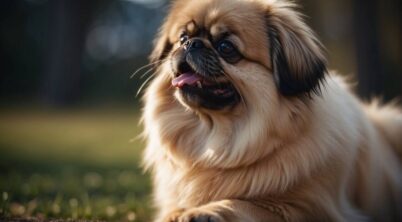The Pekingese is an ancient breed, deeply entwined with Chinese history, known for its distinctive appearance and regal demeanor. Originally bred for the Imperial Chinese court, these dogs were historically regarded as semi-divine creatures and often referred to as “sleeve dogs” due to their compact size allowing them to be carried in the voluminous sleeves of their noble owners. The breed’s international prominence surged following the Opium Wars in the mid-19th century, when British troops entered the Imperial Palace in Beijing, discovering and subsequently bringing these unique dogs to Britain. One Pekingese named Looty was even presented to Queen Victoria, becoming a symbol of the spoils of war.
Pekingese dogs bear a gestation period typical of small dog breeds. Gestation in Pekingese, also known as the pregnancy period, lasts approximately 57 to 65 days. This stage includes a series of hormonal and physical changes as they prepare for whelping. Breeders often mark the mating date to accurately calculate the due date. From the onset of pregnancy, the Pekingese requires careful attention to nutrition and health to ensure both the mother’s well-being and the development of the puppies.
This breed’s rich history carries into their presence as household pets and show dogs in modern times. Whether recounting the tale of the Pekingese who survived the Titanic disaster or celebrating the breed’s longevity and resilience, Pekingese owners are part of a storied tradition. Understanding their gestation period is crucial for breeders and pet owners alike, contributing to the careful stewardship of this ancient and noble breed.
Table of Contents
Understanding Pekingese Pregnancy
When it comes to Pekingese pregnancy, pet owners should be aware of the specific reproductive cycle, signs to identify pregnancy, and the general timeline for gestation that is typical for this breed. Accurate knowledge is key for ensuring the health of the pregnant dog and the developing embryos.
Reproductive Cycle
The reproductive cycle of a Pekingese starts with the proestrus stage, followed by estrus where ovulation occurs, and then diestrus, which is the period of pregnancy or return to normal if fertilization does not occur. Understanding this cycle helps in planning for breeding and recognizing the stages for potential pregnancy.
Identifying Pregnancy
Relaxin, a hormone detectable through blood tests, can confirm a Pekingese’s pregnancy. Early signs a Pekingese may be pregnant include behavioral changes, nipple growth, and increased appetite. By the third or fourth week, a veterinarian may perform an ultrasound or abdominal palpation to detect pregnancy. X-rays are usually recommended later in the pregnancy to count the embryos.
Pregnancy Timeline
The gestation period for a Pekingese is typically 59 to 63 days, starting from the day of fertilization. Key milestones within this period include:
- Implantation: Occurs approximately one to two weeks post-fertilization.
- Embryonic development: The embryos continue to develop, and the mother should maintain a healthy weight.
- The due date can be estimated more accurately post-implantation, and veterinarians can assist in monitoring the pregnancy’s progression.
Maintaining regular check-ups with a veterinarian ensures the Pekingese’s pregnancy is progressing normally and the puppies’ development is on track.
Health and Care During Gestation
During the gestation period, a Pekingese requires tailored care that encompasses proper nutrition, an appropriate level of activity, and regular veterinary attention to ensure the health and well-being of both the mother and the developing puppies.
Nutritional Needs
The nutritional needs of a pregnant Pekingese escalate as her pregnancy progresses. Feeding her a high-quality diet specifically formulated for pregnant dogs is crucial. This diet should be rich in proteins, fats, vitamins, and minerals to support fetal development, milk production, and the mother’s health. From the fourth week of pregnancy, the dog’s weight and food intake should be monitored closely, gradually increasing the quantity as recommended by a veterinarian.
Exercise and Activity
Maintaining a balance in physical activity during pregnancy is essential. While exercise is encouraged, it should be moderate to prevent strain. Short, leashed walks of 15 to 20 minutes will aid in keeping the pregnant Pekingese fit and prevent excessive weight gain. High-intensity activities or rough play should be avoided, especially later in the pregnancy.
Veterinary Visits and Vaccinations
Regular veterinary visits are critical for monitoring the Pekingese’s health and the puppies’ development. An ultrasound may be performed around the 25th day to confirm pregnancy and assess the litter. Vaccinations should be up-to-date but conducted under veterinary supervision because certain vaccines are contraindicated during pregnancy. Vaccination needs should be assessed on a case-by-case basis, and any vaccination program should be customized to the dog’s needs and health status.
Preparing for Whelping
When preparing for a Pekingese’s whelping, it is essential to set up an appropriate environment for delivery and be able to recognize the imminent signs of labor. Both are critical for the safety and health of the mother and her puppies.
Setting Up a Whelping Box
A whelping box serves as a safe, clean, and contained area for a Pekingese to give birth. It should be large enough for her to move around comfortably but with walls high enough to safely contain the newborn puppies. The box should be placed in a quiet corner, away from household traffic and noise, ensuring the mother feels secure during childbirth.
- Dimensions: The box should be at least 1.5 times the length of the Pekingese from nose to base of the tail.
- Materials: Use sturdy, easy-to-clean materials like wood or thick cardboard.
- Bedding: Line the box with soft, absorbent materials that are easily replaceable, such as newspapers or towels.
- Temperature: Maintain a consistent temperature around 85 degrees Fahrenheit during the first few days after birth.
- Accessibility: Include a low entrance for the mother while preventing puppies from wandering out.
Recognizing the Signs of Labor
Mother dogs typically show signs that labor is beginning, and these can be subtle or pronounced. Pekingese owners should monitor for the following:
- Nesting behavior: As labor approaches, the expectant mother may start shredding bedding materials to create a nest.
- Restlessness and discomfort: She might pace, dig, or change positions frequently, indicating contractions are starting.
- Decreased appetite: Many dogs will refuse food as labor nears.
- Temperature drop: Approximately 24 hours before labor, her body temperature will drop below 99°F.
Owners should consult their veterinarian for advice on whelping and for a supply of emergency contact numbers. A veterinarian may recommend a prenatal visit during which a hormone test, like a relaxin test, can confirm pregnancy post-mating and an ultrasound or X-ray in the later stages to estimate the number of puppies and foresee any birthing complications.
Birth and Postpartum Care
The birthing process in Pekingese and subsequent postpartum care are crucial stages that require careful attention to ensure the health and wellbeing of both the mother and her newborn puppies.
The Birthing Process
A Pekingese’s gestation period typically lasts around 63 days. When a Pekingese goes into labor, or whelping, it’s important for the owner to prepare a quiet and comfortable area for delivery. They should monitor the dog closely as she delivers her puppies. Each fetus should be born enclosed in its amniotic sac, and the mother will typically remove the sac and sever the umbilical cord herself. The owner should be prepared to assist if necessary, especially because Pekingese can sometimes struggle with giving birth due to their physical conformation.
An important aspect to watch for is the delivery of placentas, as each should follow its corresponding puppy. The American Kennel Club (AKC) advises keeping track of the number of placentas, as retained placentas can lead to serious health issues for the mother.
Caring for the Newborn Puppies
Immediately after birth, ensuring that each puppy is breathing well and starting to nurse is vital. Pekingese puppies are generally small in weight and must feed regularly to support rapid puppy development. Adequate feeding and nutrition are essential, and the mother’s milk provides necessary antibodies to the puppies. However, if a puppy is not nursing properly, the owner should consult a veterinarian for advice on supplemental feeding.
Apart from feeding, grooming the puppies is significant. Pekingese puppies can develop mats if their fur isn’t properly maintained. Gentle brushing can help prevent these issues, keeping their coat in good condition without causing stress to the sensitive newborns.
Regular monitoring by the owner or a veterinarian is crucial, especially within the first few weeks. The AKC recommends that puppies receive regular check-ups to ensure they are gaining weight and developing as expected.
Breeding and Ethics
When breeding Pekingese, ethical considerations must be at the forefront to ensure the well-being of the dogs and the integrity of the breed. Responsible breeding involves a deep understanding of the breed’s history and a commitment to maintaining breed standards.
Responsible Breeding Practices
Responsible breeding of Pekingese requires a veterinarian‘s supervision to maintain the health and safety of both the mother and the puppies. Mating should be planned with attention to the genetic health of the breed, avoiding hereditary issues common in small dogs. Breeding Pekingese should never be undertaken lightly; it is a commitment that requires understanding the AKC (American Kennel Club) standards for these ancient breeds.
- Pre-Mating Health Checks: Both male and female dogs should undergo thorough health screenings.
- Genetic Compatibility: Avoid inbreeding and aim for genetic diversity to reduce health risks.
- Birth Supervision: A veterinarian should be present during birth due to the size and shape of Pekingese, which can lead to complications.
- Postpartum Care: Monitoring and caring for the mother and pups are crucial, including decisions surrounding spaying the mother to prevent further unintended litters.
Understanding Breed History
The Pekingese, also known as the “Sleeve Dog,” is an ancient breed with a legacy steeped in Chinese history. It is believed that the breed came into prominence in the Western world after the Opium War when British forces entered the Chinese imperial palace and found the small dogs.
- Origin: The Pekingese has its roots as a revered companion in ancient China, associated with royalty.
- AKC Recognition: In the United States, the Pekingese received American Kennel Club recognition, where ethical breed standards are upheld.
It’s critical for breeders to recognize the Pekingese’s prominent history and breed for both the physical traits and the characteristic affection this breed is known for. The goal is to preserve these endearing qualities for future generations while ensuring the breed’s health and welfare.








